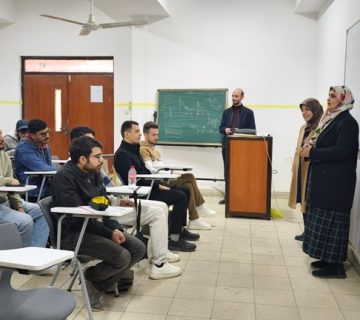The Civil Engineering Department at the College of Engineering, University of Baghdad, held on Monday 30-10-2023 M.Sc. thesis examination titled:
“Behavior of Hollow Short Square Concrete Columns Reinforced with GFRP Bars and Steel Ties”
By student Hussein Ali Hussein.
The examination committee consisted of:
- Prof. Dr. Amer Farouk Izzat / University of Baghdad/ College of Engineering (chairman).
- Prof. Dr. Wissam Kadhim Al-Saraj / Al-Mustansiriyah University / College of Engineering (member)
- Dr. Hayder Amer Al-Baghdadi / University of Baghdad/ College of Engineering (member)
- Prof. Dr. AbdulMuttailb I. Said / University of Baghdad/ College of Engineering (supervisor)
After conducting the public discussion and listening to the student’s defense, the thesis was accepted with an Excellent degree.
The thesis was summarized as follows:
Hollow-core concrete columns are often employed in utility poles, ground piles, and piers for bridges due to their great structural efficiency and efficient utilization of materials. These columns’ performance is impacted by many design parameters. However, corrosion can be a problem in steel-reinforced concrete structures. This study examines the possibility of using Glass Fiber Reinforced Polymer (GFRP) bars as an alternative to steel bars that is economically viable and non-corrosive.
In the laboratory work, twelve hollow short columns were prepared and tested until failure under a pure axial compressive load. All the columns had a hollow square section with an exterior dimension of (180×180) mm and a height of 900 mm. They were divided into four groups. The studied variables were the steel reinforcement ratio, the GFRP reinforcement ratio, the hollow ratio, spacing between ties, and reinforcement type.
According to the results obtained from the experimental work, the contribution of the longitudinal GFRP bars can be reliably predicted by assuming that the compressive strength of the GFRP bars is equivalent to 35% of the average tensile strength of the GFRP bars. There was a significant enhancement in the ultimate load-carrying capacity of hollow square GFRP column specimens when increasing the internal GFRP longitudinal reinforcement. Increasing the GFRP reinforcement ratio from 1.46% to 2.9%, 3.29%, 4.9%, and 5.85% enhanced the axial bearing load by 32.3%, 43.9%, 60.5%, and 71.7%, respectively. In contrast to steel-reinforced hollow column specimens and with the same reinforcement ratio (1.46%, 3.29%, and 4.9%), the findings revealed that GFRP specimens had a decrease in the axial bearing load by 13.1%, 9.2%, and 9.4%, respectively. Also, a decrease in load capacity was observed in the hollow columns with an increased hollow ratio due to the reduced cross-sectional area. When the hollow ratio decreased from 0.15 to 0.07, the axial load capacity increased by 29.2%. When the hollow ratio increased from 0.15 to 0.25, the axial load capacity decreased only by 4.5%. Decreasing the spacing between internal lateral ties led to an increase in ultimate load-carrying capacity. Decreasing the spacing between the lateral ties from 170 mm to 120 mm and 85 mm Increased the axial bearing load by 10.8% and 14%, respectively.
Finally, columns were modeled and analyzed using ABAQUS software. The results of the numerical analysis showed good agreement with the experimental side in terms of failure modes and load-deflection curves








